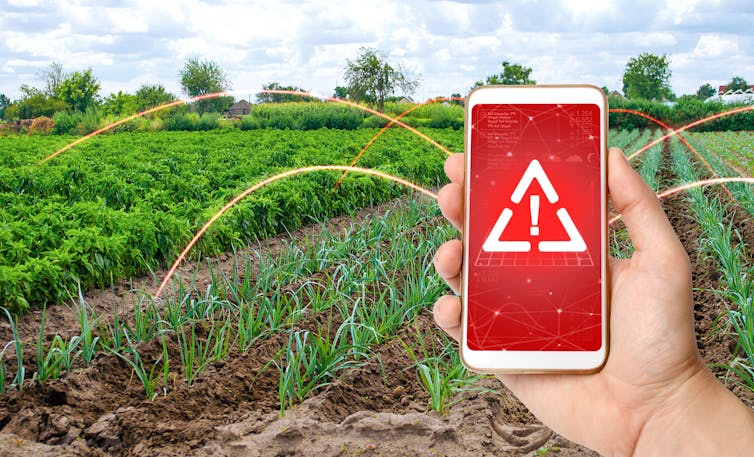Some plants can short-circuit the toxic effects of metals – now scientists are trying to harness their power

Andrii Yalanskyi/Shutterstock
Marshall Keyster, University of the Western Cape
At first glance, it’s hard to see what gold, iron, lead, arsenic, silver, platinum and tin have in common. A look at the periodic table will clear up the confusion: they are all heavy metals, typically categorised as those metals with an atomic weight and density at least five times greater than water.
These and other heavy metals occur naturally in the environment, and in some cases, in our bodies. They’re mostly considered harmless but at certain levels of exposure they can be toxic to human, plant and animal life. Being over exposed to heavy metals can stunt plants’ growth and lower seed production.
Some plants have evolved traits that increase their tolerance of heavy metals. Many researchers, myself among them, believe that understanding and harnessing these evolutionary traits may allow us to protect agricultural crops from the bad effects of heavy metal toxicity.
My research focuses on improving the tolerance of plants to heavy metals, which is particularly important in a country like South Africa, where mining activities contaminate soils. These soils are critical for agriculture.
Even plants in the same family use different strategies to cope with metals. Some take up the metals in their roots and transfer them to their leaves; others take up the metals and hold them (immobile) in their roots. This is important for food security and food safety since we want plants that can limit metal uptake into their edible parts. However, as my colleagues and I outline in a recent review paper, it’s no easy task to harness these strategies.
Exposure and risk
Heavy metal stress or toxicity in plants happens when they are exposed to heavy metals in the soil.
That exposure is usually the result of waste and pollutants from human activities like agriculture, mining and industry. In South Africa, mining has been a leading culprit of heavy metal pollution.
This inhibits plants’ growth or their ability to convert sunlight into essential energy through photosynthesis. Or it may affect how they assimilate nutrients, or how they respond to drought or harmful pathogens.
This has implications for the production of food crops. Studies around the world have found that heavy metal toxicity can reduce crop yields as well as their quality. Medicinal plants can also be affected by heavy metals.
How plants do it
Plants have evolved some mechanisms to fend off heavy metals effects. I study one of these: signalling mechanisms that plants use to control the uptake of heavy metals – their “immune” response to heavy metals.
In much the same way as the human immune system is alerted to, monitors and responds to a pathogen, plants have evolved signalling mechanisms that help them to regulate their tolerance to heavy metals.
These signalling mechanisms are impressive. For example, plants can trigger signalling events to release low-molecular-weight ligands (ions or molecules) that tightly bind to the heavy metals and prevent them from moving from the roots.
But they’re far from perfect. As human viruses like HIV and SARS-CoV-2 (the coronavirus behind COVID-19) have shown, certain pathogens can short-circuit the immune system. Heavy metals can do the same to the plant’s signalling mechanisms by mimicking essential nutrients; for instance, the metal vanadium resembles phosphate.
Heavy metals like copper have also been shown to damage the membrane integrity of the cell walls in the roots of plants. Similarly, heavy metals can disrupt the construction of these cell walls; weakened walls make the cell lose structural integrity, which exposes the cellular membranes and causes cell death.
Heavy metals can also impair the work of the plasma membrane, which regulates the transport of material in and out of the plant cells. This blocks the uptake of essential nutrients by negating the function of numerous transporter proteins at work in the plasma membranes.
Useful lessons
Despite their shortcomings, these signalling mechanisms are powerful. That’s why I study them: if we can tap into the way in which plants adapt to the threats from heavy metals, there’s a chance that soil contaminated with heavy metals can be rejuvenated through the use of the right plants, or that this tolerance can be passed on to other plants, including food crops.
Our ongoing work, and that of others, is promising, but it’s still early days. Perhaps one day soon, plants’ clever adaptations will signal a change in how we deal with heavy metal toxicity.![]()
Marshall Keyster, Associate professor, University of the Western Cape
This article is republished from The Conversation under a Creative Commons license. Read the original article.
related Articles
CoE-FS co-director Lise Korsten awarded prestigious hon doc from Ghent University
Five tips to better food safety in the kitchen
Here are five tips to better food safety in the kitchen: Always wash counters, knives and containers. Photo Kaboompics.com/Pexels. 2….
CoE-FS flag flies high at 8th World One Health Congress
Prof Lise Korsten, CoE-FS co-director and Food Safety lead, presents at the 8th World One Health Congress. Photo 8th World…



